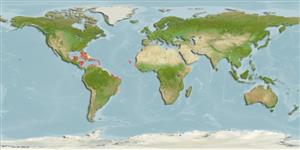Pycnogonida |
Pantopoda |
Ammotheidae
Environment: milieu / climate zone / djupintervall / distribution range
Ekologi
; djupintervall 0 - 10 m (Ref. 116112). Tropical
Western and Central Atlantic: Belize, West Africa, Bahamas, Senegal and USA.
Length at first maturity / Size / Weight / Age
Könsmognad: Lm ? range ? - ? cm
Trunk with 3 sharply pointed median tubercles bearing lateral setae; lateral processes with similar dorsodistal tubercles; lateral processes and legs variously setose, with many or few setae per segment. Neck moderately short; ocular tubercle slightly taller than its basal diameter, placed medially, with bulbous swelling just posterior on neck. Neck sometimes with lateral setae. Proboscis broadly oval, with proximal constriction only. Abdomen long, extending just posterior to distal rim of first coxae of fourth legs. Chelifore scapes 1 segmented, very short, sometimes bent ventrally. Oviger typical. Legs short, setose; femoral cement gland(s) not evident. Claw moderately short, of equal length on all legs (Ref. 2115, p. 21).
From Intertidal depths, some subtidally (Ref. 2115, page 21). Epibiotic (Ref. 116112).
Life cycle and mating behavior
Könsmognad | Reproduktion | Lek | Eggs | Fecundity | Larvae
Members of the class Pycnogonida are gonochoric and sexually dimorphic. During copulation, male usually suspends itself beneath the female. Fertilization occurs as the eggs leave the female's ovigers. Males brood the egg masses until they hatch. Life cycle: Eggs hatch into protonymphon larva then to adults.
Child, C.A. 1992 Shallow-water Pycnogonida of Gulf of Mexico. Memoirs of the Hourglass Cruises 9:1-86. Florida Department Natural Resources, Bureau of Marine Resources, Jan. 1992. (Ref. 2115)
IUCN Red List Status
(Ref. 130435: Version 2025-1)
CITES status (Ref. 108899)
Not Evaluated
Not Evaluated
Threat to humans
Human uses
| FishSource |
Verktyg
Ytterligare information
Trophic EcologyFood items (preys)
Födosammansättning
Födointag
Predatorer
Population dynamicsTillväxt
Max. ages / sizes
Length-weight rel.
Length-length rel.
Length-frequencies
Mass conversion
Abundans
PhysiologySyreförbrukning
Human RelatedStamps, coins, misc.
Internet-källor
Estimates based on models
Preferred temperature
(Ref.
115969): 26.3 - 28.1, mean 27.2 (based on 106 cells).
Price category
Unknown.
